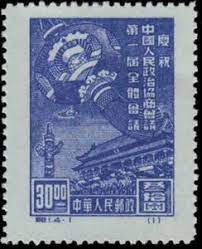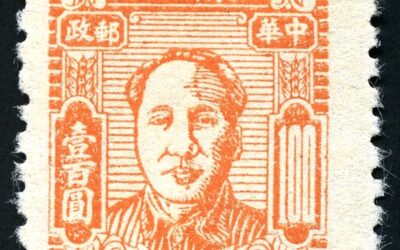Stamp of the day
SEPARATION OF STAMPS: Serpentine rouletting
In 1860 a new, and now very famous separation methodology was introduced in Finland– the serpentine rouletting. The indentation depth between the teeth was so extreme that the individual stamps looked very odd, as you can see from the picture. This methodology worked,...
SEPARATION OF STAMPS: Postmaster rouletting
Around the world there are many examples of the so called “Postmaster rouletting” where local postmasters rouletted former imperforated stamps. Todays stamp is an example from USA: “ After the need for imperforate sheets of 400 of the 1912 1-cent and 2-cent Washington...
SEPARATION OF STAMPS: Rouletting
Rouletting uses small cuts in the paper instead of holes. In 1847, Henry Archer of the United Kingdom constructed the first (rouletting) machine, the "Archer Roulette", to separate stamps. His plan, submitted to the Postmaster General on 1 October 1847, was referred...
SEPARATION OF STAMPS: Comb perforation
SEPARATION OF STAMPS: Comb perforation Comb perforation is when the perforation pins have been arranged in a comb pattern to perforate three sides of a stamp in one stroke. You can recognize a comb perforated stamp by the fact, that the corner teeth look alike....
SEPARATION OF STAMPS: Line perforation
Line perforation comprises several steps: the sheet of stamps is first perforated horizontally, then vertically, until the whole sheet is perforated. This is an imprecise process, meaning it can result in lines and gaps of different sizes. You can recognize a line...
SEPARATION OF STAMPS: perforation
From around 1855 - 1860 stamp sheets were perforated with small holes, so that the single stamps could be separated more easily. The perforation was measured according to the number of holes pr. 2 cm. Todays stamp is showing the National Museum in Reykjavik and was...
SEPARATION OF STAMPS: imperforated
The vast majority of classic stamps that were issued from 1840 until about 1855-1860 were imperforated. The individual stamps therefore had to be cut out of the sheet with scissors. It was a difficult and time-consuming process, which often destroyed the stamps....
CLASSIC STAMPS: China
Mao proclaimed the establishment of the People's Republic of China from the Gate of Heavenly Peace (Tian'anmen) on 1 October 1949. The unified administration issued its first postage stamps on October 8, 1949, consisting of a set of four depicting a lantern and the...
CLASSIC STAMPS: China
Mao Zedong first appeared on a stamp from China in 1944, at a time when his Communist forces had been cooperating (for the most part) with the Nationalist Government for seven years against the Japanese forces invading China. These first stamps were very primitive....
CLASSIC STAMPS: China
The first new designs of the Republic of China were two commemorative sets of 12 each, the first set depicting Sun Yat-sen and second Yuan Shikai, both issued on 14 December 1912. Todays stamp is the 1 cent issue from the first set depicting Sun Yat-sen. CV is 1,50 $.
CLASSIC STAMPS: China
The revolution in China of 1911 resulted in overprints ("Republic of China" from top to bottom: simplified Chinese: 中华民国 traditional Chinese: 中華民國) on the imperial stamps in 1912. The stamps were overprinted in Foochow, Nanking and Shanghai. An additional set of...
CLASSIC STAMPS: China
The revolution in China of 1911 resulted in overprints ("Republic of China" from top to bottom: simplified Chinese: 中华民国 traditional Chinese: 中華民國) on the imperial stamps in 1912. The stamps were overprinted in Foochow, Nanking and Shanghai. An additional set of...
CLASSIC STAMPS: China
The first set of commemorative stamps was issued on November 16, 1894, the 60th birthday of Empress Dowager Tzu Hsi. A total of nine different stamps were issued. But the Chinese postal service came into being only two years later. A full 18 years after the issuance...
CLASSIC STAMPS: China
Three series of "Large Dragons" were published in the period from 1878 until 1883. In the fall of 1885 a new series of "Small Dragons" was issued. Three values, were issued with the face value of 1, 3 and 5 candareens. The dragons were smaller in size in comparison to...
CLASSIC STAMPS: China
Regular government postal service in China is known from the Zhou dynasty in the 1st millennium BC. During the Yuan dynasty under Kublai Khan in the 12th century, China was integrated into the much larger Mongolian Örtöö system. Marco Polo reported that there were...
CLASSIC STAMPS: Finland
The first stamp from Finland, which did not alone show the Finnish coat of arms, was issued in 1922, five years after the country's independence. It was published in honor of the "Red Cross". This stamp has a face value of one Markka and an additional value of 50...
CLASSIC STAMPS: Finland
In 1875 a single stamp with a face value of 32 penni was issued. It shows, like all other stamps from Finland at the time, the Finnish coat of arms This is the first stamp from Finland with “normal” perforation (14:13½). Today's stamp is a fine cancelled copy. The...
CLASSIC STAMPS: Finland
In 1866, six stamps with six different denominations were issued. Denominations were in a new currency, "penni" and "markka". The stamps are available in no less than five different types of rouletting. Collecting these stamps is truly for specialists. Today's stamp...
CLASSIC STAMPS: Finland
In 1860 two stamps were issued with a face value of 5 and 10 kopek. The stamps are depicting the coat of arms of Finland. A new, and now very famous separation methodology was used – the serpentine rouletting. The indentation depth between the teeth was so extreme...
CLASSIC STAMPS: Finland
CLASSIC STAMPS: Finland In the war of 1808-1809, Russian troops conquered Finland. Finland had been a part of Sweden and was annexed to the Russian empire at the Peace Treaty of Hamina on 17 September 1809. Finland became an autonomous Grand Duchy of the Russian...
CLASSIC STAMPS: France
Definitive French stamps, featuring a brand new design, were issued between 1876 and 1900. This new design, officially known as the Peace and Commerce Issue, features allegorical images of "Peace" and "Commerce" holding hands above a World globe. Todays stamp is the 2...
CLASSIC STAMPS: France
The Second French Empire was an Imperial Bonapartist regime of Napoleon III that lasted from 14 January 1852 to 27 October 1870. In July 1870, Napoleon III reluctantly declared war on Prussia after pressure from the general public. The French Army was rapidly defeated...
CLASSIC STAMPS: France
CLASSIC STAMPS: France In 1869 France issued its first large-sized stamp. It was a 5 Franc stamp depicting Emperor Napoleon III in the middle and 5 F to the left and the right of the portrait. The stamp has been printed in three types according to the number of...
CLASSIC STAMPS: France
The Second French Empire was an Imperial Bonapartist regime of Napoleon III from 14 January 1852 to 27 October 1870, between the Second and the Third Republic of France. Because of this political change, the inscription at the top of the French stamps changed from...
CLASSIC STAMPS: France
The first stamps of France were issued on 1 January 1849. They were designed by Jacques-Jean Barre. The medallion depicts the head of goddess Ceres facing left. In 1852 a new series of definitive stamps were issued, retaining the inscription "REPUB FRANC" but...
CLASSIC STAMPS: France
The first French mail service was set up to serve the King and the Royal Court on 19 June 1464. In 1490 the Counts of Thurn and Taxis set up an international service. The mail service in France developed gradually and was eventually made available to everyone in 1603....
INDIAN STATES: Bijawar
INDIAN STATES: Bijawar The native states of India, also known as feudatory or princely states, were typically vassals under a local or regional ruler who owed allegiance to the British Raj. There were about 675 native states in all but many were not parts of British...
INDIAN STATES: Bhor
The native states of India, also known as feudatory or princely states, were typically vassals under a local or regional ruler who owed allegiance to the British Raj. There were about 675 native states in all but many were not parts of British India proper because...
INDIAN STATES: Bhopal
The native states of India, also known as feudatory or princely states, were typically vassals under a local or regional ruler who owed allegiance to the British Raj. There were about 675 native states in all but many were not parts of British India proper because...
INDIAN STATES: Barwani
The native states of India, also known as feudatory or princely states, were typically vassals under a local or regional ruler who owed allegiance to the British Raj. There were about 675 native states in all but many were not parts of British India proper because...






























